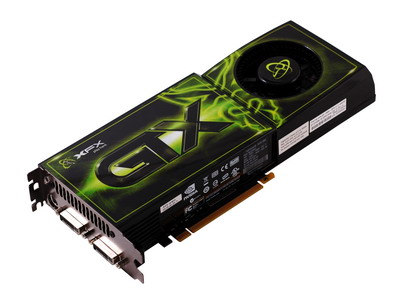|
DEGIMA
The DEGIMA (DEstination for Gpu Intensive MAchine) is a high performance computer cluster used for hierarchical N-body simulations at the Nagasaki Advanced Computing Center, Nagasaki University. The system consists of a 144-node cluster of PCs connected via an InfiniBand interconnect. Each node is composed of 2.66 GHz Intel Core i7 920 processor, two GeForce GTX295 graphics cards, 12 GB DDR3-1333 memory and Mellanox MHES14-XTC SDR InfiniBand host adapter on MSI X58 pro-E motherboard. Each graphics card has two GT200 GPU chips. As a whole, the system has 144 CPUs and 576 GPUs. It runs astrophysical N-body simulations with over 3,000,000,000 particles using the Multiple-Walk parallel treecode. The system is noted for being highly cost and energy-efficient, having a peak performance of 111 TFLOPS with an energy efficiency of 1376 MFLOPS/watt. The overall cost of the hardware was approximately US$500,000.Hamada T., Nitadori K. (2010) 190 TFlops astrophysical N-body simulation ... [...More Info...] [...Related Items...] OR: [Wikipedia] [Google] [Baidu] |
Computer Cluster
A computer cluster is a set of computers that work together so that they can be viewed as a single system. Unlike grid computers, computer clusters have each node set to perform the same task, controlled and scheduled by software. The components of a cluster are usually connected to each other through fast local area networks, with each node (computer used as a server) running its own instance of an operating system. In most circumstances, all of the nodes use the same hardware and the same operating system, although in some setups (e.g. using Open Source Cluster Application Resources (OSCAR)), different operating systems can be used on each computer, or different hardware. Clusters are usually deployed to improve performance and availability over that of a single computer, while typically being much more cost-effective than single computers of comparable speed or availability. Computer clusters emerged as a result of convergence of a number of computing trends including t ... [...More Info...] [...Related Items...] OR: [Wikipedia] [Google] [Baidu] |
Supercomputing In Japan
Japan operates a number of centers for supercomputing which hold world records in speed, with the K computer becoming the world's fastest in June 2011. and Fugaku took the lead in June 2020, and furthered it, as of November 2020, to 3 times faster than number two computer. The K computer's performance was impressive, according to professor Jack Dongarra who maintains the TOP500 list of supercomputers, and it surpassed its next 5 competitors combined. The K computer cost US$10 million a year to operate. Previous records Japan's entry into supercomputing began in the early 1980s. In 1982, Osaka University's LINKS-1 Computer Graphics System used a massively parallel processing architecture, with 514 microprocessors, including 257 Zilog Z8000, Zilog Z8001 Central processing unit, control processors and 257 iAPX IAPX 86, 86/20 Floating-point unit, floating-point processors. It was mainly used for rendering realistic 3D computer graphics, 3D computer graphics. It was the world's most ... [...More Info...] [...Related Items...] OR: [Wikipedia] [Google] [Baidu] |
N-body Simulation
In physics and astronomy, an ''N''-body simulation is a simulation of a dynamical system of particles, usually under the influence of physical forces, such as gravity (see ''n''-body problem for other applications). ''N''-body simulations are widely used tools in astrophysics, from investigating the dynamics of few-body systems like the Earth-Moon-Sun system to understanding the evolution of the large-scale structure of the universe. In physical cosmology, ''N''-body simulations are used to study processes of non-linear structure formation such as galaxy filaments and galaxy halos from the influence of dark matter. Direct ''N''-body simulations are used to study the dynamical evolution of star clusters. Nature of the particles The 'particles' treated by the simulation may or may not correspond to physical objects which are particulate in nature. For example, an N-body simulation of a star cluster might have a particle per star, so each particle has some physical significa ... [...More Info...] [...Related Items...] OR: [Wikipedia] [Google] [Baidu] |
Nagasaki University
is a national university of Japan. Its nickname is ''Chōdai'' (). The main campus is located in Bunkyo-machi, Nagasaki City, Nagasaki Prefecture, Japan. History Nagasaki University was established in 1949 by incorporating several national institutions, namely, Nagasaki Medical College (including College Hospital and College of Pharmaceutical Sciences), Nagasaki College of Economics, Nagasaki Normal School, Nagasaki Youth Normal School and Nagasaki High School. The new main campus (Bunkyo Campus) was formerly a plant site of Mitsubishi Arms Factory (Ohashi Plant). Nagasaki Medical College The oldest of the predecessors was Nagasaki Medical College. It was founded in November 1857 as by the branch office of Tokugawa Shogunate. The first professor was J. L. C. Pompe van Meerdervoort, and the institute was one of the first western-style (not ''Kampō'') medical schools in Japan. In 1861 the hospital was founded, and after Meiji Restoration the school became a public (prefe ... [...More Info...] [...Related Items...] OR: [Wikipedia] [Google] [Baidu] |
InfiniBand
InfiniBand (IB) is a computer networking communications standard used in high-performance computing that features very high throughput and very low latency. It is used for data interconnect both among and within computers. InfiniBand is also used as either a direct or switched interconnect between servers and storage systems, as well as an interconnect between storage systems. It is designed to be scalable and uses a switched fabric network topology. By 2014, it was the most commonly used interconnect in the TOP500 list of supercomputers, until about 2016. Mellanox (acquired by Nvidia) manufactures InfiniBand host bus adapters and network switches, which are used by large computer system and database vendors in their product lines. As a computer cluster interconnect, IB competes with Ethernet, Fibre Channel, and Intel Omni-Path. The technology is promoted by the InfiniBand Trade Association. History InfiniBand originated in 1999 from the merger of two competing designs: F ... [...More Info...] [...Related Items...] OR: [Wikipedia] [Google] [Baidu] |
Intel Core
Intel Core is a line of streamlined midrange consumer, workstation and enthusiast computer central processing units (CPUs) marketed by Intel Corporation. These processors displaced the existing mid- to high-end Pentium processors at the time of their introduction, moving the Pentium to the entry level. Identical or more capable versions of Core processors are also sold as Xeon processors for the server and workstation markets. The lineup of Core processors includes the Intel Core i3, Intel Core i5, Intel Core i7, and Intel Core i9, along with the X-series of Intel Core CPUs. Outline Although Intel Core is a brand that promises no internal consistency or continuity, the processors within this family have been, for the most part, broadly similar. The first products receiving this designation were the Core Solo and Core Duo Yonah processors for mobile from the Pentium M design tree, fabricated at 65 nm and brought to market in January 2006. These are substantially diffe ... [...More Info...] [...Related Items...] OR: [Wikipedia] [Google] [Baidu] |
GeForce 200 Series
The GeForce 200 series is a series of Tesla-based GeForce graphics processing units developed by Nvidia. Architecture The GeForce 200 Series introduced Nvidia's second generation of Tesla (microarchitecture), Nvidia's unified shader architecture; the first major update to it since introduced with the GeForce 8 Series. The GeForce GTX 280 and GTX 260 are based on the same processor core. During the manufacturing process, GTX chips were binned and separated through defect testing of the core's logic functionality. Those that fail to meet the GTX 280 hardware specification are re-tested and binned as GTX 260 (which is specified with fewer stream processors, less ROPs and a narrower memory bus). In late 2008, Nvidia re-released the GTX 260 with 216 stream processors, up from 192. Effectively, there were two GTX 260 cards in production with non-trivial performance differences. The GeForce 200 series GPUs (GT200a/b GPU), excluding GeForce GTS 250, GTS 240 GPUs (these are older G ... [...More Info...] [...Related Items...] OR: [Wikipedia] [Google] [Baidu] |
DDR3 SDRAM
Double Data Rate 3 Synchronous Dynamic Random-Access Memory (DDR3 SDRAM) is a type of synchronous dynamic random-access memory (SDRAM) with a high bandwidth (" double data rate") interface, and has been in use since 2007. It is the higher-speed successor to DDR and DDR2 and predecessor to DDR4 synchronous dynamic random-access memory (SDRAM) chips. DDR3 SDRAM is neither forward nor backward compatible with any earlier type of random-access memory (RAM) because of different signaling voltages, timings, and other factors. DDR3 is a DRAM interface specification. The actual DRAM arrays that store the data are similar to earlier types, with similar performance. The primary benefit of DDR3 SDRAM over its immediate predecessor DDR2 SDRAM, is its ability to transfer data at twice the rate (eight times the speed of its internal memory arrays), enabling higher bandwidth or peak data rates. The DDR3 standard permits DRAM chip capacities of up to 8 gigabits (Gbit), and up to four ranks ... [...More Info...] [...Related Items...] OR: [Wikipedia] [Google] [Baidu] |
Mellanox
Mellanox Technologies Ltd. ( he, מלאנוקס טכנולוגיות בע"מ) was an Israeli-American multinational supplier of computer networking products based on InfiniBand and Ethernet technology. Mellanox offered adapters, switches, software, cables and silicon for markets including high-performance computing, data centers, cloud computing, computer data storage and financial services. On March 11, 2019, Nvidia announced its intent to acquire the company for $6.9 billion. Other companies willing to acquire Mellanox were Intel, Xilinx and Microsoft. The deal closed on April 27, 2020, with approval from the EU, U.S. and Chinese antitrust authorities. The company was integrated into Nvidia's networking division in 2020 and Nvidia stopped using the brand name "Mellanox" for its new networking products. History 1999–2009 Mellanox was founded in May 1999 by former Israeli executives of Intel Corporation and Galileo Technology (which was acquired by Marvell Technology Group ... [...More Info...] [...Related Items...] OR: [Wikipedia] [Google] [Baidu] |
Micro-Star International
Micro-Star International Co., Ltd (MSI; ) is a Taiwanese multinational information technology corporation headquartered in New Taipei City, Taiwan. It designs, develops and provides computer hardware, related products and services, including laptops, desktops, motherboards, graphics cards, All-in-One PCs, servers, industrial computers, PC peripherals, car infotainment products, etc. The company has a primary listing on the Taiwan Stock Exchange and was established on August 4, 1986 by 5 founders – Hsu Xiang (a.k.a. Joseph Hsu), Huang Jinqing (a.k.a. Jeans Huang), Lin Wentong (a.k.a. Frank Lin), Yu Xian'nengyu (a.k.a. Kenny Yu), and Lu Qilong (a.k.a. Henry Lu). First starting its business in New Taipei City, Taiwan, MSI later expanded into China, setting up its Bao'an Plant in Shenzhen in 2000 and establishing research and development facilities in Kunshan in 2001. It also provides global warranty service in North America, Central/South America, Asia, Australia and Europe. ... [...More Info...] [...Related Items...] OR: [Wikipedia] [Google] [Baidu] |
FLOPS
In computing, floating point operations per second (FLOPS, flops or flop/s) is a measure of computer performance, useful in fields of scientific computations that require floating-point calculations. For such cases, it is a more accurate measure than measuring instructions per second. Floating-point arithmetic Floating-point arithmetic is needed for very large or very small real numbers, or computations that require a large dynamic range. Floating-point representation is similar to scientific notation, except everything is carried out in base two, rather than base ten. The encoding scheme stores the sign, the exponent (in base two for Cray and VAX, base two or ten for IEEE floating point formats, and base 16 for IBM Floating Point Architecture) and the significand (number after the radix point). While several similar formats are in use, the most common is ANSI/IEEE Std. 754-1985. This standard defines the format for 32-bit numbers called ''single precision'', as well as 6 ... [...More Info...] [...Related Items...] OR: [Wikipedia] [Google] [Baidu] |
Performance Per Watt
In computing, performance per watt is a measure of the energy efficiency of a particular computer architecture or computer hardware. Literally, it measures the rate of computation that can be delivered by a computer for every watt of power consumed. This rate is typically measured by performance on the LINPACK benchmark when trying to compare between computing systems: an example using this is the Green500 list of supercomputers. Performance per watt has been suggested to be a more sustainable measure of computing than Moore’s Law. System designers building parallel computers, such as Google's hardware, pick CPUs based on their performance per watt of power, because the cost of powering the CPU outweighs the cost of the CPU itself. Spaceflight computers have hard limits on the maximum power available and also have hard requirements on minimum real-time performance. A ratio of processing speed to required electrical power is more useful than raw processing speed. D. J. Shirley; ... [...More Info...] [...Related Items...] OR: [Wikipedia] [Google] [Baidu] |






